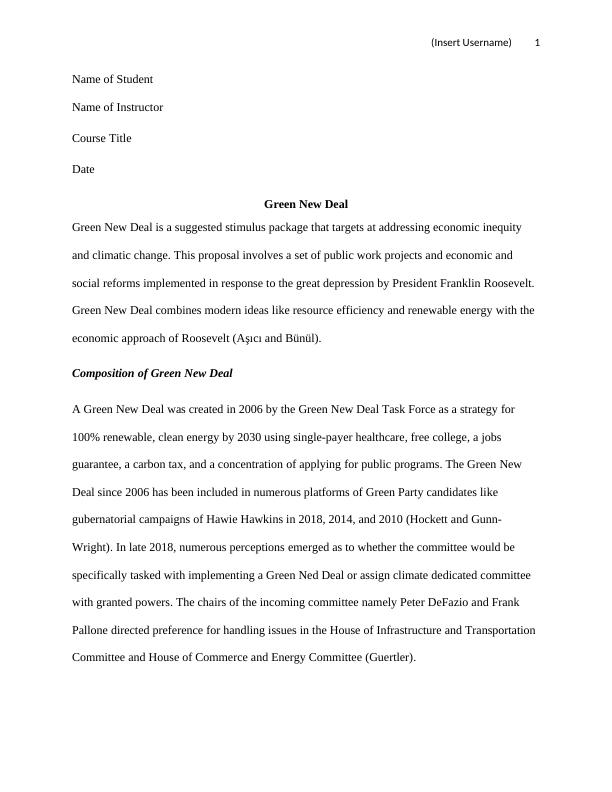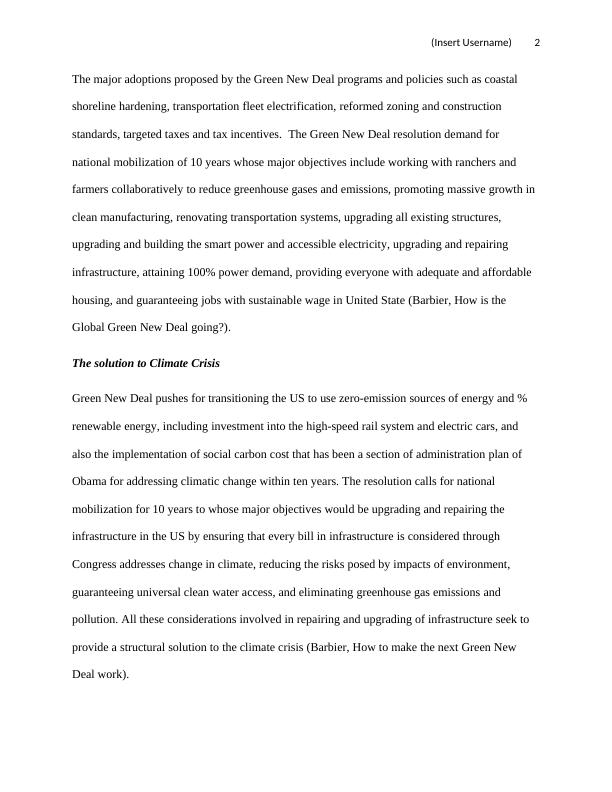Green New Deal: Addressing Economic Inequity and Climate Change
Added on 2023-03-21
7 Pages1793 Words37 Views
(Insert Username) 1
Name of Student
Name of Instructor
Course Title
Date
Green New Deal
Green New Deal is a suggested stimulus package that targets at addressing economic inequity
and climatic change. This proposal involves a set of public work projects and economic and
social reforms implemented in response to the great depression by President Franklin Roosevelt.
Green New Deal combines modern ideas like resource efficiency and renewable energy with the
economic approach of Roosevelt (Aşıcı and Bünül).
Composition of Green New Deal
A Green New Deal was created in 2006 by the Green New Deal Task Force as a strategy for
100% renewable, clean energy by 2030 using single-payer healthcare, free college, a jobs
guarantee, a carbon tax, and a concentration of applying for public programs. The Green New
Deal since 2006 has been included in numerous platforms of Green Party candidates like
gubernatorial campaigns of Hawie Hawkins in 2018, 2014, and 2010 (Hockett and Gunn-
Wright). In late 2018, numerous perceptions emerged as to whether the committee would be
specifically tasked with implementing a Green Ned Deal or assign climate dedicated committee
with granted powers. The chairs of the incoming committee namely Peter DeFazio and Frank
Pallone directed preference for handling issues in the House of Infrastructure and Transportation
Committee and House of Commerce and Energy Committee (Guertler).
Name of Student
Name of Instructor
Course Title
Date
Green New Deal
Green New Deal is a suggested stimulus package that targets at addressing economic inequity
and climatic change. This proposal involves a set of public work projects and economic and
social reforms implemented in response to the great depression by President Franklin Roosevelt.
Green New Deal combines modern ideas like resource efficiency and renewable energy with the
economic approach of Roosevelt (Aşıcı and Bünül).
Composition of Green New Deal
A Green New Deal was created in 2006 by the Green New Deal Task Force as a strategy for
100% renewable, clean energy by 2030 using single-payer healthcare, free college, a jobs
guarantee, a carbon tax, and a concentration of applying for public programs. The Green New
Deal since 2006 has been included in numerous platforms of Green Party candidates like
gubernatorial campaigns of Hawie Hawkins in 2018, 2014, and 2010 (Hockett and Gunn-
Wright). In late 2018, numerous perceptions emerged as to whether the committee would be
specifically tasked with implementing a Green Ned Deal or assign climate dedicated committee
with granted powers. The chairs of the incoming committee namely Peter DeFazio and Frank
Pallone directed preference for handling issues in the House of Infrastructure and Transportation
Committee and House of Commerce and Energy Committee (Guertler).

(Insert Username) 2
The major adoptions proposed by the Green New Deal programs and policies such as coastal
shoreline hardening, transportation fleet electrification, reformed zoning and construction
standards, targeted taxes and tax incentives. The Green New Deal resolution demand for
national mobilization of 10 years whose major objectives include working with ranchers and
farmers collaboratively to reduce greenhouse gases and emissions, promoting massive growth in
clean manufacturing, renovating transportation systems, upgrading all existing structures,
upgrading and building the smart power and accessible electricity, upgrading and repairing
infrastructure, attaining 100% power demand, providing everyone with adequate and affordable
housing, and guaranteeing jobs with sustainable wage in United State (Barbier, How is the
Global Green New Deal going?).
The solution to Climate Crisis
Green New Deal pushes for transitioning the US to use zero-emission sources of energy and %
renewable energy, including investment into the high-speed rail system and electric cars, and
also the implementation of social carbon cost that has been a section of administration plan of
Obama for addressing climatic change within ten years. The resolution calls for national
mobilization for 10 years to whose major objectives would be upgrading and repairing the
infrastructure in the US by ensuring that every bill in infrastructure is considered through
Congress addresses change in climate, reducing the risks posed by impacts of environment,
guaranteeing universal clean water access, and eliminating greenhouse gas emissions and
pollution. All these considerations involved in repairing and upgrading of infrastructure seek to
provide a structural solution to the climate crisis (Barbier, How to make the next Green New
Deal work).
The major adoptions proposed by the Green New Deal programs and policies such as coastal
shoreline hardening, transportation fleet electrification, reformed zoning and construction
standards, targeted taxes and tax incentives. The Green New Deal resolution demand for
national mobilization of 10 years whose major objectives include working with ranchers and
farmers collaboratively to reduce greenhouse gases and emissions, promoting massive growth in
clean manufacturing, renovating transportation systems, upgrading all existing structures,
upgrading and building the smart power and accessible electricity, upgrading and repairing
infrastructure, attaining 100% power demand, providing everyone with adequate and affordable
housing, and guaranteeing jobs with sustainable wage in United State (Barbier, How is the
Global Green New Deal going?).
The solution to Climate Crisis
Green New Deal pushes for transitioning the US to use zero-emission sources of energy and %
renewable energy, including investment into the high-speed rail system and electric cars, and
also the implementation of social carbon cost that has been a section of administration plan of
Obama for addressing climatic change within ten years. The resolution calls for national
mobilization for 10 years to whose major objectives would be upgrading and repairing the
infrastructure in the US by ensuring that every bill in infrastructure is considered through
Congress addresses change in climate, reducing the risks posed by impacts of environment,
guaranteeing universal clean water access, and eliminating greenhouse gas emissions and
pollution. All these considerations involved in repairing and upgrading of infrastructure seek to
provide a structural solution to the climate crisis (Barbier, How to make the next Green New
Deal work).

(Insert Username) 3
Green New Deal also responds to the climate crisis by encouraging building resilient structures
against disasters related to climate change such as adverse weather conditions through providing
investments and leveraging funding for strategies and projects that are a community defined.
This proposal also demands the upgrade of all existing structures and buildings in the US as well
as the construction of new structures and buildings to attain durability, comfort, affordability,
water efficiency, and optimum energy efficiency. The deal also promotes international services,
funding, products, expertise, and technological exchange with the objective of ensuring that the
US is the international leader on action against climate change and to assist other states to attain
the Green New Deal. The deal proposes cleaning up of abandoned sites and present hazardous
waste to ensure sustainability and economic development on those sites (Lyne).
Green New Deal proposes on the minimizing pollution and removal of greenhouse gases from
the atmosphere by restoring the natural ecosystem through proven low-technology solutions that
promote the storage of soil carbon like afforestation and land preservation. The last structural
solution to the climate crisis is the repairing transportation system in the US to eliminate
greenhouse gas emission and pollution from the sector of transportation and also technological
feasibility by including investments in high-speed rail, accessible, affordable, and clean public
transit, also zero-emission vehicle manufacturing and infrastructure (Schwartzman).
Issues of Equality
The adoption of Green New Deal in the United States addresses the issues of equality by
proposing the provision of all people of the United States with access to nature, affordable,
healthy, clean air, and clean water, and also economic security, adequate, safe, and affordable
housing, and high-quality health care without any discrimination based on social status or
background. The deal also ensures a commercial environment where each businessperson is free
Green New Deal also responds to the climate crisis by encouraging building resilient structures
against disasters related to climate change such as adverse weather conditions through providing
investments and leveraging funding for strategies and projects that are a community defined.
This proposal also demands the upgrade of all existing structures and buildings in the US as well
as the construction of new structures and buildings to attain durability, comfort, affordability,
water efficiency, and optimum energy efficiency. The deal also promotes international services,
funding, products, expertise, and technological exchange with the objective of ensuring that the
US is the international leader on action against climate change and to assist other states to attain
the Green New Deal. The deal proposes cleaning up of abandoned sites and present hazardous
waste to ensure sustainability and economic development on those sites (Lyne).
Green New Deal proposes on the minimizing pollution and removal of greenhouse gases from
the atmosphere by restoring the natural ecosystem through proven low-technology solutions that
promote the storage of soil carbon like afforestation and land preservation. The last structural
solution to the climate crisis is the repairing transportation system in the US to eliminate
greenhouse gas emission and pollution from the sector of transportation and also technological
feasibility by including investments in high-speed rail, accessible, affordable, and clean public
transit, also zero-emission vehicle manufacturing and infrastructure (Schwartzman).
Issues of Equality
The adoption of Green New Deal in the United States addresses the issues of equality by
proposing the provision of all people of the United States with access to nature, affordable,
healthy, clean air, and clean water, and also economic security, adequate, safe, and affordable
housing, and high-quality health care without any discrimination based on social status or
background. The deal also ensures a commercial environment where each businessperson is free

End of preview
Want to access all the pages? Upload your documents or become a member.
Related Documents
Assignment about Candidate job experiencelg...
|5
|1246
|14
Impact of Climate Change on Business and Steps for Reducing Carbon Footprintslg...
|7
|1314
|222
Building a sustainable organisation: Climate change impact on businesses and steps for reducing carbon footprintslg...
|7
|1231
|227
